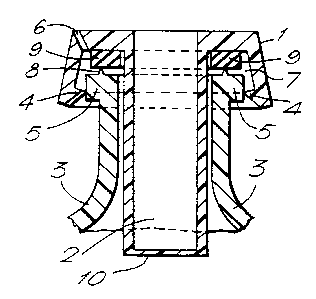Une partie des informations de ce site Web a été fournie par des sources externes. Le gouvernement du Canada n'assume aucune responsabilité concernant la précision, l'actualité ou la fiabilité des informations fournies par les sources externes. Les utilisateurs qui désirent employer cette information devraient consulter directement la source des informations. Le contenu fourni par les sources externes n'est pas assujetti aux exigences sur les langues officielles, la protection des renseignements personnels et l'accessibilité.
L'apparition de différences dans le texte et l'image des Revendications et de l'Abrégé dépend du moment auquel le document est publié. Les textes des Revendications et de l'Abrégé sont affichés :
| (12) Brevet: | (11) CA 2197230 |
|---|---|
| (54) Titre français: | CONTENANT AVEC BOUCHON ET METHODE DE REMPLISSAGE DES CONTENANTS SANS BULLES DE GAZ |
| (54) Titre anglais: | CONTAINER WITH CLOSURE CAP AND METHOD OF FILLING CONTAINERS WITHOUT GAS BUBBLES |
| Statut: | Durée expirée - au-delà du délai suivant l'octroi |
| (51) Classification internationale des brevets (CIB): |
|
|---|---|
| (72) Inventeurs : |
|
| (73) Titulaires : |
|
| (71) Demandeurs : |
|
| (74) Agent: | SMART & BIGGAR LP |
| (74) Co-agent: | |
| (45) Délivré: | 2008-12-09 |
| (86) Date de dépôt PCT: | 1995-08-11 |
| (87) Mise à la disponibilité du public: | 1996-02-29 |
| Requête d'examen: | 2002-08-08 |
| Licence disponible: | S.O. |
| Cédé au domaine public: | S.O. |
| (25) Langue des documents déposés: | Anglais |
| Traité de coopération en matière de brevets (PCT): | Oui |
|---|---|
| (86) Numéro de la demande PCT: | PCT/EP1995/003183 |
| (87) Numéro de publication internationale PCT: | EP1995003183 |
| (85) Entrée nationale: | 1997-02-10 |
| (30) Données de priorité de la demande: | ||||||
|---|---|---|---|---|---|---|
|
Un capuchon de fermeture qui permet de fermer des récipients sans gaz repousse une partie du contenu du récipient lorsqu'il est posé sur le col du récipient et permet en même temps au gaz contenu dans le récipient de s'échapper par une ou plusieurs ouvertures avant que le capuchon de fermeture ne soit verrouillé dans sa position de fermeture.
A closure cap for sealing containers without gas bubbles
displaces some of the contents of the container when
fitted onto the neck of the container and at the same
time allows any trapped gas to escape through one or
more vents before the closure cap engages in the closure
position.
Note : Les revendications sont présentées dans la langue officielle dans laquelle elles ont été soumises.
Note : Les descriptions sont présentées dans la langue officielle dans laquelle elles ont été soumises.

2024-08-01 : Dans le cadre de la transition vers les Brevets de nouvelle génération (BNG), la base de données sur les brevets canadiens (BDBC) contient désormais un Historique d'événement plus détaillé, qui reproduit le Journal des événements de notre nouvelle solution interne.
Veuillez noter que les événements débutant par « Inactive : » se réfèrent à des événements qui ne sont plus utilisés dans notre nouvelle solution interne.
Pour une meilleure compréhension de l'état de la demande ou brevet qui figure sur cette page, la rubrique Mise en garde , et les descriptions de Brevet , Historique d'événement , Taxes périodiques et Historique des paiements devraient être consultées.
| Description | Date |
|---|---|
| Inactive : CIB expirée | 2023-01-01 |
| Inactive : Périmé (brevet - nouvelle loi) | 2015-08-11 |
| Accordé par délivrance | 2008-12-09 |
| Inactive : Page couverture publiée | 2008-12-08 |
| Inactive : Taxe finale reçue | 2008-09-22 |
| Préoctroi | 2008-09-22 |
| Un avis d'acceptation est envoyé | 2008-04-28 |
| Lettre envoyée | 2008-04-28 |
| Un avis d'acceptation est envoyé | 2008-04-28 |
| Inactive : Approuvée aux fins d'acceptation (AFA) | 2008-03-28 |
| Modification reçue - modification volontaire | 2008-02-05 |
| Inactive : Dem. de l'examinateur par.30(2) Règles | 2007-08-06 |
| Modification reçue - modification volontaire | 2006-12-08 |
| Inactive : Dem. de l'examinateur par.30(2) Règles | 2006-06-08 |
| Inactive : CIB de MCD | 2006-03-12 |
| Modification reçue - modification volontaire | 2005-10-12 |
| Inactive : Dem. de l'examinateur par.30(2) Règles | 2005-04-12 |
| Inactive : Dem. traitée sur TS dès date d'ent. journal | 2002-08-27 |
| Lettre envoyée | 2002-08-27 |
| Inactive : Renseign. sur l'état - Complets dès date d'ent. journ. | 2002-08-27 |
| Exigences pour une requête d'examen - jugée conforme | 2002-08-08 |
| Toutes les exigences pour l'examen - jugée conforme | 2002-08-08 |
| Lettre envoyée | 1997-12-15 |
| Inactive : Demandeur supprimé | 1997-08-13 |
| Inactive : Lettre de courtoisie - Preuve | 1997-03-18 |
| Demande publiée (accessible au public) | 1996-02-29 |
Il n'y a pas d'historique d'abandonnement
Le dernier paiement a été reçu le 2008-07-23
Avis : Si le paiement en totalité n'a pas été reçu au plus tard à la date indiquée, une taxe supplémentaire peut être imposée, soit une des taxes suivantes :
Les taxes sur les brevets sont ajustées au 1er janvier de chaque année. Les montants ci-dessus sont les montants actuels s'ils sont reçus au plus tard le 31 décembre de l'année en cours.
Veuillez vous référer à la page web des
taxes sur les brevets
de l'OPIC pour voir tous les montants actuels des taxes.
Les titulaires actuels et antérieures au dossier sont affichés en ordre alphabétique.
| Titulaires actuels au dossier |
|---|
| BOEHRINGER INGELHEIM KG |
| Titulaires antérieures au dossier |
|---|
| BERNHARD FREUND |
| HEINRICH KLADDERS |
| JOACHIM EICHER |
| JOACHIM JAEGER |
| WULF BACHTLER |